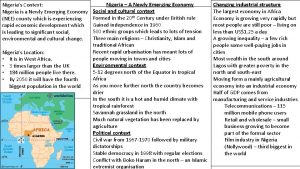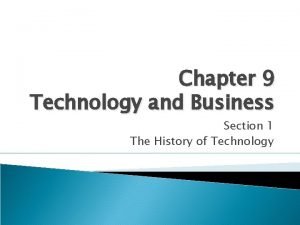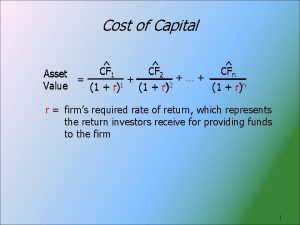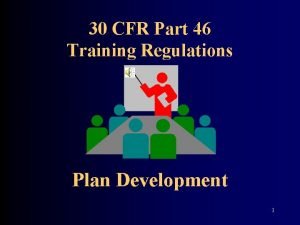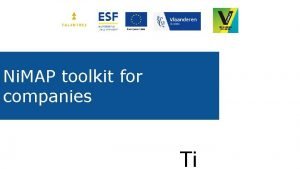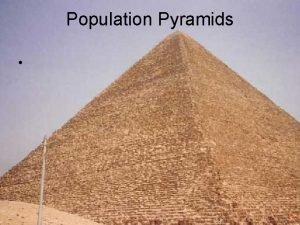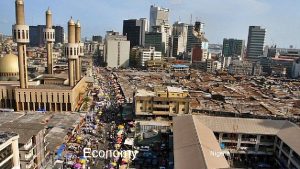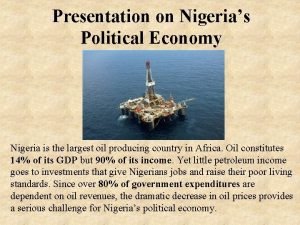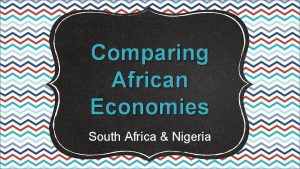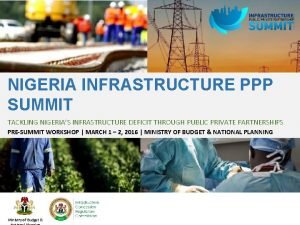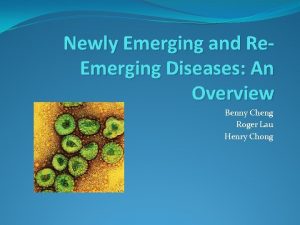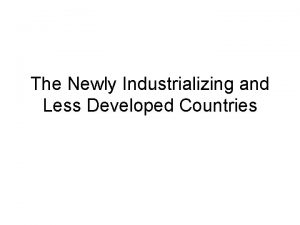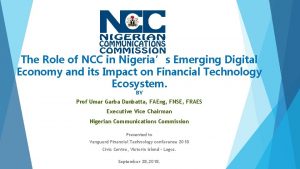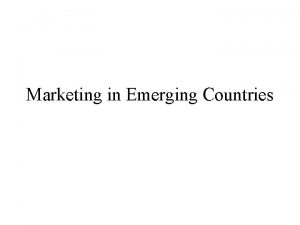Nigerias Context Nigeria is a Newly Emerging Economy














- Slides: 14

Nigeria’s Context: Nigeria is a Newly Emerging Economy (NEE) county which is experiencing rapid economic development which is leading to significant social, environmental and cultural change. Nigeria’s Location: • It is in West Africa. • 3 times larger than the UK • 184 million people live there. • By 2050 it will have the fourth biggest population in the world . Nigeria – A Newly Emerging Economy Social and cultural context Formed in the 20 th Century under British rule Gained independence in 1960 500 ethnic groups which leads to lots of tension Three main religions – Christianity, Islam and traditional African Recent rapid urbanisation has meant lots of people moving in towns and cities Environmental context 5 -12 degrees north of the Equator in tropical Africa As you move further north the country becomes drier In the south it is a hot and humid climate with tropical rainforest Savannah grassland in the north Much natural vegetation has been replaced by agriculture Political context Civil war from 1967 -1970 followed by military dictatorships Stable democracy in 1998 with regular elections Conflict with Boko Haram in the north – an Islamic extremist organisation Changing industrial structure The largest economy in Africa Economy is growing very rapidly but most people are still poor – living on less than US$1. 25 a day A growing inequality – a few rich people some well-paying jobs in cities Most wealth in the south around Lagos with greater poverty in the north and south-east Moving form a mainly agricultural economy into an industrial economy Half of GDP comes from manufacturing and service industries Telecommunications – 115 million mobile phone users Retail and wholesale – small business growing to become part of the formal sector Film industry in Nigeria (Nollywood) – third biggest in the world

How can manufacturing industry stimulate economic development? • New manufacturing industries can increase the pace of economic development in Nigeria in several ways: • Improving the standard of living by products of industries such as cement • Producing manufactured goods in the country reduces the need to import goods and can be cheaper • New industries create jobs, give people an income and contribute to the country’s wealth through taxes • The expansion of Nigerian companies into other countries increases Nigeria’s influence in the region • • Nigeria – A Newly Emerging Economy Trans-National Corporations (TNCs) In Nigeria TNCs pay a large role in industrial development. When TNCs operate in a country they build factories which provide jobs for the local people and the government can receive taxes from this. The TNCs spend money on developing the local infrastructure (roads & services) which make the lives of the local people better. Advantages of TNCs to the host country Bring new investment into the country’s economy Provide jobs, often at higher levels than average in the local economy Bring expertise and new skills that the country does not have Have international links that bring access to world markets Provide new technology that helps economic development Nigeria’s changing political and trading relationships in the wider world Relationship with Britain – Strong trading relationship from colonial times with palm oil and slavery. Now Nigeria exports lots of natural commodities to Britain in exchange for imported manufactured goods Nigeria still trades with the UK but now does lots of business with the USA, China, India and the EU. Since independence, oil has replaced other natural commodities as Nigeria’s main export. But the country still manufactured goods like machinery, chemicals and transport equipment Relationship with China – Main export partner for manufactured goods. China is investing in Nigeria to improve its infrastructure. China’s economy and people need lots of resources so its economy can grow and the quality of life continue to improve Disadvantages of TNCs to the host country Take profits out of the country to pay shareholders or to invest elsewhere Wage levels in LICs and NEEs are usually lower than HICs Can cause environmental damage and deplete natural resources TNCs can withdraw their investment from a country if they wish They are powerful organisation can exert political influence over the government in a country • TNCs such as Shell which drills for oil has had a large environmental impact on Nigeria • Oil spills from leaking pipelines damage farmland so crops no longer grow • Gas flares are used to burn off gas from the oil. Apart from being wasteful, the fumes affect people’s health and contribute to global warming • Oil heated by the sun becomes highly flammable and can burn out of control • Oil pollution, which occurs offshore from tankers, kills fish in the sea

Official Development Assistance Given by governments and paid for by taxes. Fr this reason, it is sometimes unpopular with taxpayers in those countries Multilateral aid Given by countries through international organisation, like the World Bank or International Monetary Fund (IMF) Bilateral aid Given directly by one country to another. Sometimes it is tied aid, with conditions attached. For example, the recipient may be required to buy goods from the donor country with the aid Voluntary aid Given by individuals or companies and distributed through charities and nongovernmental organisations (NGOs) like OXFAM Short-term emergency aid To cope with immediate problems caused by disasters like earthquakes and wars Long-term development assistance Helps people to improve their lives through education, healthcare or agricultural development Nigeria – A Newly Emerging Economy The effects of economic development on quality of life for the population Aid has been very useful in Nigeria – from 2009 -2013, 60 million mosquito nets were distributed to households across Nigeria as part of an internal aid project funded by the World bank, IMF and USA government. Aid in Nigeria AID is defined as helping a person or a country. There are many different types of AID. Most AID in Nigeria is international aid. Quality of life can be measured in a number of ways. The Human Development Index (HDI) combines life expectancy, years of schooling and Gross National Income (GNI)

Why is Rio important? Where is Rio? Rio is a large coastal city located on the South-East coast of Brazil Rio is important nationally because…. . Second largest city in Brazil Main tourist destination – Christ the Redeemer and the Carnival Population of approximately 6 million people Second largest city of industrial production as well as its financial and service industries (chemicals, pertroleum, processed foods, pharmaceuticals, textiles, clothing and furniture). Rio is important internationally because… Host the 2016 Olympics and Para Olympics Major oil reserves and industrial powerhouse Largest economy in Latin America Rio, Brazil – A city in a NEE Why is Rio growing? Rural-to-urban migration – people moving from the countryside to the city Natural increase – people having more babies. As more people live in towns and cities there will be an increase in births Push Factors Poor healthcare No jobs Poor sanitation Drought War No food Poor housing Pull Factors Good healthcare Jobs Good sanitation Clean water Access to food No crime Protection from persecution Social opportunities Sick children can get treated. Anti-biotics are available in the hospitals for babies Economic opportunities Easier to get permits for travel and business Lots of people in the city to sell goods to What opportunities has urban growth created? – These are good things that cities provide for people who move there: Children can go to school and get qualifications for the Consistent electricity supply so machines always run future making it easier to make money Water is cleaner in the city New industrial areas (Santa Cruz) – this has attracted lots businesses and industry such as sawmills Satellite TV and good electricity supply Access to good schools and university New businesses like sawmills cause new businesses to set up such as paper shop and a machine repair business

Challenges/problems Rio, Brazil – A city in a NEE Issue Challenges Solutions Health care Only 55% of the city had a local family health clinic Services for pregnant women are very poor Many favelas are inaccessible on steep slopes and crowded – doctors took health kits to each house and tested for 20 diseases and treated them Infant mortality decreased Education Only half of children above the age of 14 go to school School enrolment is low because A shortage of nearby schools A lack of money and the need to work A shortage of teachers Low pay and poor training for teachers Encourage local people to volunteer to help in school Give grants to poor kids Make money available for free lessons in volleyball & squash in the favelas Water supply 12% of people in Rio do not have access to running water 37% of water is lost through leaky pipes 7 new treatment plants built between 1998 and 2014 Over 300 km of pipes were laid By 2014 95% of population had a mains water supply Energy The whole city suffers frequent blackouts Made worse during the world cup and the Olympics Many people in the poorest parts get their electricity illegally – this is risky and unsafe Installing 60 km of new power lines Building a new nuclear generator Developing the new Simplicio hydroelectric complex which will increase Rio’s supply of electricity by 30% Effects of economic growth Rio provides 6% of all employment in Brazil Lots of jobs in service industries – finance, tourism and retail Lots of jobs in manufacturing – steel, oil with associated import & export Unemployment • Big recession in 2015 – increased unemployment and with high taxes led to riots • 20% unemployment in the favelas • Lots people in the informal economy – not regulated & taxed but low paid Crime • Pacifying Police Units (UPPs) were established to reclaim favelas from drug dealers • Police have taken control of crime-dominated Complexo do Alemao and 30 smaller favelas • • • Favela-Bairro Project – Helps the poor in Rio’s Favelas Urban planning scheme can help reduce the impact of the problems/challenges and improve the quality of life The project ran from 1995 -2008 and involved 253, 000 Social improvements: day care centres for pupils, adult education classes, services to help with drug addiction Economic improvements: people getting legal ownership of their properties and running training schemes to help people find better jobs ENV improvements: wooden buildings being replaced with brick buildings, streets have been widened and paved, and there are now rubbish collection services

Environmental problems with urban growth Air pollution Problems Heavy traffic and congestion on roads causes a build-up of exhaust fumes Steep mountains – roads can only be built on coastal lowlands Tunnels are need to connect different areas of the city 40% increase in the number of cars Solutions Expansion of the metro system New toll roads to reduce congestion Make coast roads one-way during rush hours to improve traffic flow Water pollution Problems Ends up on the beaches – could put of tourists and the country loses vital income 55 rivers heavily polluted 200 tonnes of raw sewage enters the bay every day Solutions 12 new sewage works have been built since 2004 at a cost of US$ 68 million Ships fined for discharging fuel into the bay illegally 5 km of new sewage pipes have been installed around badly polluted areas Waste pollution Problems Biggest problems in the favelas Built on steep slopes with few proper roads – difficult for waster collection trucks to access Dumped in the streets and water sources – causes diseases like cholera and encourages rats Solutions Power plant set up to make methane from rotting rubbish – 30 tonnes of rubbish a day makes enough electricity for 1000 homes Rio, Brazil – A city in a NEE How can we improve squatter settlements? Self-help occurs where local authorities support the residents of the squatter settlements in improving their homes. This involves the improvements outlined above, but it is more organised. There is cooperation between residents to work together and remove rubbish. There is also cooperation from local authority, which offers grants, cheap loans and possibly materials to encourage improvements to take place. Standpipes are likely to be provided for access to water supply and sanitation. Collectively, the residents, with help from the local authority, may begin to build health centres and schools. Legal ownership of the land is granted to encourage improvements to take place, marking an acceptance of the housing. Site and service schemes are a more formal way of helping squatter settlements residents. Land is identified for the scheme. The infrastructure is laid in advance of settlement, so that water, sanitation and electricity are properly supplied in individually marked plots. People then build their homes using whatever materials they can afford at the time. They can add to and improve the structure if finances allow later. Characteristics and problems of squatter settlements · settlements are unplanned so the houses do not have basic infrastructure such as sanitation, piped water, electricity and road access · houses are made of any material available nearby - corrugated iron, pieces of board - haphazardly assembled to provide a basic shelter · houses have a simple layout that may have a living area separate from a sleeping area · parents and large families inhabit a small shack which is often overcrowded and the squatter settlements are very overcrowded · there are no toilets, water must be collected from a nearby source - often at a cost - and carried back · rubbish is not collected and the area quickly degenerates into a place of filth and disease · the inhabitants tend to create poorly paid jobs where the income is unreliable or they work in the less wellpaid jobs part of the formal sector · quality of life is poor; the housing and environment are largely responsible for this · the residents have very little money so cannot improve their homes or environments · crime is a problem, children often do not go to school, the family lives on top of each other, there is no privacy, disease is rife and life is one of trying to survive from one day

What is development? Development is the progress in economic growth, use of technology and improving welfare that a country has made. When a country develops it gets better for the people and their quality of life improves (their wealth, health and safety). Changing Economic World – Measuring Development indicators – we use these (see table below) to measure how successful a country has been. Issues: Individual indicators can be misleading if they are used on their own because as a country develops some aspects develop before others. So it might seem that a country is more developed than it is. Using more than one measure of development (i. e. wealth and something else), or using the human development index avoids these problems Name What it is A measure of…. . As a country develops it gets…. Gross National Income (GNI) The total value of goods and services produced by a country in a year, including income from oversea. It often given in US$. Wealth Higher GNI per head The GNI divided by the population of a country. It’s also often given in US$ and is sometimes known called GNI per capita Wealth Higher Gross Domestic Product (GDP) The total value of goods and services a country produces in a year. It’s often given in US$ Wealth Higher Birth Rate The number of live babies born per thousand of the population per year Women’s rights Lower Death Rate The number of deaths per thousand of the population per year Health Lower Infant Mortality rate The number of babies who die under 1 year old, per thousand babies born Health Lower People per doctor The average number of people for each doctor Health Lower Literacy rate The % of adults who can read and write Education Higher Access to safe water The % of people who can get clean drinking water Health Higher Life expectancy The average a person can expect to live to Health Higher Human Development Index (HDI) This is a number that’s calculated using life expectancy, literacy rate, education level (e. g. average number of years of schooling) and income per head. Every country had an HDI value between 0 (least developed) and 1 (most developed) Lots of things Higher Using wealth on its own cause problems: GNI per head can be very misleading when used on its own because it is an average – variations within the country do not show up It can hide big variations between regions in the country, and between classes – the rich in big cities may have much higher measures of development than the poor in rural areas. For example if you looked at the GNI per head of Russia it might seem quite developed (because it is high enough to be a HIC), but in reality there a small number of extremely wealthy people and a lot of very poor people Countries are classified in different ways: HICs – (Higher income countries) – the wealthiest countries in the world where GNI per head is high and most citizens have a high quality of life, e. g. UK, USA NEEs – (Newly Emerging Economies) are rapidly getting richer as their economy is moving from being based on primary industry (e. g. agriculture) to secondary industry (manufacturing). Quality of life for many citizens is improving, e. g. China, Brazil, Nigeria LICs – (Lower Income Countries) – are the poorest countries in the world where the GNI per head is very low and most citizens have a low quality of life, e. g. Somalia, Uganda, Nepal

Development and the DTM Changing Economic World – Measuring Development is linked to the Demographic Transition Model (DTM) • The DTM shows how changing birth rates and death rates affect population growth • When the birth rate is higher than the death rate, more people are being born than are dying so the population grows – this is called natural increase. Its called natural decrease when the death’s rate’s higher than the birth rate • Birth rates and death rates differ from country to country. This means that population growth is faster in some countries than others, especially in less developed countries Stage 1 – least developed stage – birth rate is high as there’s no use of contraception. People have lots of children because poor healthcare means that many infants die. The death rate is also high due to poor healthcare or famine, and life expectancy is low (few people reach old age). Income is low. Stage 2 – not very developed – many LICs in stage 2. The economy is based on agriculture so people have lots of children to work on farms, which means that birth rates are high. Death rates fall due to improved healthcare and diet so life expectancy increases. Stage 3 – more developed – most NEE are at stage 3. The birth rate falls rapidly as women have a more equal place in society and better education. The use of contraception increases and more women work instead of having children. The economy also changes to manufacturing, so income increases and fewer children are need to work on farms> Healthcare improves so life expectancy increases. Stage 4 & 5 – most developed = most HICs are at one of these stages. Birth rates are low because people want possessions and a high quality of life, and may have dependent elderly relatives, so there is loess money available for having children. Healthcare is good, so the death rate is low and life expectancy is high. Income is high

Causes of uneven development Changing Economic World – Measuring Development All these things stop countries from making money, therefore they can spend on infrastructure, schools, hospitals Physical factors can affect how developed a country is. . A poor climate • Too hot, dry, cold – not much will grow – so no crops grow. This can lead to malnutrition • People can sell fewer crops, so get less money to spend on services • Govt. gets less money from taxes Poor farming land • Land is too steep or has poor soil cannot grow food Few raw materials • Countries with none cannot sell anything to make money • Some countries have loads but do not have the money available to develop/use them Lots of natural hazards • These damage infrastructure which means the country has to spend money in fixing hospitals and schools rather than actually making the country better Historical reasons for uneven development Colonisation • Countries were taken over by countries with a higher level of development. When they are given independence their level of development has been depressed • European countries controlled the economies of these countries and removed the raw materials to make manufactured goods – this meant Africa was reliant on the rich countries which led to famine & malnutrition Conflicts • Wars & civil wars can reduce levels of development – healthcare gets worse. • More money is spent on guns and fighting rather than development & damage is done to infrastructure Economic factors can cause uneven development Poor trade links • Trade is the exchange of goods and services • World trade patterns can influence their level of development • If a country has poor trade links, it won’t make lots of money. so there’ll be less to spend on development Lots of debt • Countries borrow money to spend on development projects – however there is interest charged so end up paying lots more money back than they originally loaned An economy based on primary products • Primary products do not cost a lot of money to buy, so poor countries do not make a lot of money from selling them • The primary products go to the rich countries who then manufacture them into other products which they can sell for more money - This keeps the poor countries poor Uneven development has consequences Wealth – this is not spread evenly cross the world Health – healthcare is better in some countries than others and people live longer in HICs than LICs International migration – due to the differences above in countries people move from poor to rich countries Reducing the global development gap Aid – given to one country as money or resources. Can be spent on development projects (dams or wells etc. ) to help the country develop. Can be wasted or used by corrupt Govts. Fair trade – making sure farmers get a fair deal. Companies who want to sell Fair Trade have to pay producers a fair price. This is more expensive for shoppers where the money is used on schools. However only a small amount goes to the farmers most goes to the retailers. Intermediate/Appropriate technology – tools and machines that will approve quality of life but are also simple to use, affordable to buy or build and cheap to maintain. Solar powered LED lightbulbs allows people in Nigeria to work at night – making more money. Debt Relief – the debt is cancelled so the poor country can top paying interest. The saved money can be spend on development Investment – Foreign-Direct Investment - people/companies buy property or infrastructure in another. This leads to better access to finance, technology and expertise and improved infrastructure and an increase in services Industrial development - Agriculture dominates the economy in poor countries but switching to manufacturing means they can sell products to make more money Tourism – by people visiting the country they spend money which the Govt. can use on development Microfinance loans – small loans given to people in LICs who cannot get them from banks. They can start their own business

Changing Economic World – Measuring Development Topic: Development Gap Energy – Resources option – Question 6 – Global demand for energy Context: How the growth of tourism in an Lower Income Country (LIC) helps to close the development gap Energy security depends on Energy Production and Consumption • Energy security means having a reliable, uninterrupted and affordable supply of energy available Country: Kenya, East Africa • It depends on the supplies available (either produced or imported), the Background: size of the population and the amount of energy that a typical person uses Kenya is a LIC in East Africa. • Producing more energy than is required by the population is an energy It attracts tourists because of its tribal culture, safari wildlife, warm climate and surplus (this can then be exported to the other countries). Having too little beautiful unspoilt scenery. energy to meet people’s needs is a deficit, Kenya’s government is trying to boost tourism as a way of increasing its development. o Visa fees for adults were cut by 50% in 2009 to make it cheaper to visit the country. They were also scrapped for children under 16 to encourage more families to visit. o Landing fees at airports on the Kenyan coast have been dropped for charter airlines. o Tourism has increased from 0. 9 million visitors per year in 1995 to 1. 8 million in 2011 Effectiveness – Benefits Tourism now contributes over 12% of Kenya’s GDP – money that can be spent on development and improving quality of life Nearly 600, 000 people are directly or indirectly employed by the tourism industry – that 1 -% of all employment in Kenya The 24 national parks charge entry fees to tourists. This money is used to maintain the national parks which helps to protect the environment and wildlife Since 2000, Kenya’s score on the Human Development Index has increased from 0. 45 to 0. 55 Effectiveness - Negatives Only a small proportion of the money earned goes to locals. The rest goes to big companies, often based in High Income Countries overseas, so doesn’t help to close the development gap Some Maasai tribespeople were forced off their land to create national parks for tourists Tourist vehicles damage the environment, e. g. safari vehicles destroying vegetation and disturbing animals Example questions: Using an example explain how tourism can reduce the development gap – 6 marks Assess the effectiveness of tourism in reducing the development gap in a LIC or NEE you have studied – 9 marks Global demand for energy is increasing: • World’s population is increasing – more people need more energy • Economic development in NEE means people have more money so buy more things which use energy – cars, fridges etc. • Technological advances have created loads of new devices that all need energy – computers, mobiles – these are becoming more popular so more energy is needed Global energy production is unevenly distributed: Some countries produce lots of energy as they have large energy reserves and the money to do so (UK) Some countries produce little energy as they have few resources or are unable to exploit their resources due to a lack of money or political instability (Sudan) Global energy consumption is unevenly distributed: Wealthy developed countries consume lots of energy person as they can afford to. Most people I these countries have access to electricity and heating and use energy-intensive devices Poorer, less developed countries consume less energy person as they are less able to afford it. Less energy is available and lifestyles are less dependent on high energy consumption than in wealthier counties. Energy supply – factors affecting it – energy supply varies across the world Physical factors Economic factors Political factors Technological factors Unequal distribution of energy sources – some countries have more resources than others Fossils fuels are nonrenewable so run out eventually Variations in Geography can influence the potential of areas for renewable energy Hard to get the remaining non-renewable energy sources left Prices of fossil fuels are very changeable due to economic & political factor – some countries may not be able to afford the price rises Costs of getting to energy sources is too high Wars and political instability in countries with large energy reserves can affect their ability to export their resources Climate change led to international agreements to reduce carbon emissions – cannot burn as much fossil fuels Concerns over the safety of nuclear power Some countries are not able to exploit their energy resources as the technology required is unavailable or too expensive

Energy insecurity has a range of impacts As fossil fuels get use up, reserves in more difficult and environmentally sensitive areas are explored. This increases the cost of producing energy and risks environmental damage. Demand for cleaner and cheaper energy sources increases demand for biofuels. Growing crops for biofuels has negative impacts on the environment and takes up land that could be used for growing food. Energy shortages and higher energy costs reduce industrial output – factories have to produce less due to power cuts Potential for political instability or conflict between countries with an energy surplus and those with an energy deficit Sustainable energy This provides energy today without preventing future generations from meeting their energy needs It is important because demand for energy is increasing as the world’s population is increasing but non-renewable energy resources are running out We need to find new renewable energy sources and use energy more efficiently so that future generations can meet their energy needs A carbon footprint is a measure of energy use This is a measure of the amount of greenhouse gases an individual’s activities produce This includes direct emissions (produced rom things that use energy e. g. heating) and indirect emissions (produced making things that we buy e. g. food & clothing) Energy can be conserved in various ways Sustainable design Increasing efficiency Demand reduction Insulating walls – traps in heat Modern boilers – more efficient so waste less energy Switch to electric cars Hybrid cars – combine diesel and electricity to become more efficient Power stations and engines are becoming more efficient Switching off lights in empty rooms Improve public transport and encourage walking Energy – Resources option – Question 6 – Global demand for energy Sustainable energy sources Biomass – burning wood or animal waste or used to produce biofuels, limited technology, only renewable if the biomass used is managed sustainably Wind – wind blows and the turbines turns a generator – on land or out at sea – no CO 2 once the turbines have been installed – not always windy Solar – energy is used to heat water and electricity generated using photovoltaic cells. Solar cookers are cheap – good in LICs – the cells are expensive Hydro – uses the energy of falling water. Water is trapped by a dam and allowed to fall through tunnels to turn the turbines. Dams destroy environments and communities and are expensive Tidal – waves turn a turbines to power a generator. Does not work all day long but can reliably predicted Wave – wind blowing across the water makes waves, which drives turbines and generates electricity. Expensive and does not produce much energy in calm conditions Geothermal – water pumped into the mantle, the surrounding heat turns it to steam, the steam rises and turns turbines to generate electricity. Cheap to set up but every country has tectonically active areas Non-renewable sources will run out Fossil fuels – the supply of fossil fuels can be increased by searching for new reserves to exploit or by exploiting reserves that have been discovered but not yet used. As technology develops, it has become possible to extract resources that were previously too difficult or costly to use Nuclear – can be used to generate a large amount of energy. Power plants very expensive to build and get rid of them, nuclear waste is hard to dispose of safely. Accidents could be catastrophic. New technology is making them more efficient –no CO 2 given off.

Energy – Resources option – Question 6 – Global demand for energy Topic: Energy Context: Extracting fossil fuels has advantages and disadvantages Topic: Energy Context: Local renewable energy scheme in a Newly Emerging Economy Country: Rice Husks in Bihar, India Bihar is a rural state in north-east India Background: 85% of people who live there are not connected to the electricity grid – particularly in Fracking is a way of extracting shale gas – natural gas that is trapped underground in shale rock rural areas Liquid is pumped into the shale rock at high pressure. This causes the rock to crack (fracture), If they are connected it is a very unreliable supply releasing the gas, which is then collected as it comes back out the well. The scheme started in 2007 to use local biomass to supply homes with electricity The scheme used rice husks – a waste product from producing rice for food Advantages: Disadvantages: How does it work: Advantages: There appears to be lots shale gas Gas is not a sustainable energy source. Rice husks are collected and used to It is very efficient as the energy sources available in the UK. Fracking increases It’s non-renewable, and releases generate electricity in small local do not have to be transported long power plants distances the energy security of the UK as carbon dioxide when it’s burned – Each power station can supply homes The electricity produced does not need supplies of other fossil fuels start contributing to global warming within a 1. 5 km range to be transferred over long distances to running out There’s a risk of pollution of By 2015 – 84 rice husk powered plants places Gas is less polluting that other fossil groundwater, drinking water and air were operating – supply around Using biomass has reduced the need fuels. It releases half the carbon It uses lots water (a limited resource) 200, 000 for Kerosene lamps in rural homes and dioxide of coal It’s known to cause small earthquakes so reduced the use of fossil fuels The power plants provide employment Fracked gas is a cheaper source than It’s an issue that people feel strongly for local people – they are trained in some renewables – although it can about. Public opposition has stopped management, operation or cost more to extract than gas from it from being used yet in the UK maintenance. some other sources Investment in fracking may slow The scheme is sustainable as it reduces The technology has already been down the investment in renewable the reliance on external organisation tested (in the USA) and shown to energy and expertise The government now offers financial work, unlike some renewable sources support to help set up biomass plants Example questions: Country: Fracking in the UK To what extent do the advantages of extracting fossil fuels outweigh the disadvantages? 9 marks Example questions: Use an example to illustrate the features of a local energy scheme in a Newly Emerging Economy (NEE) – 6 marks

Global distribution of resources We need resources such as food water and energy which are needed for basic human development People need food and water to survive and stay healthy Energy is needed for a basic standard of living - to provide lighting and heat for cooking Access to food water and energy affects the economic and social well-being or people and countries Global supply and consumption of resources is uneven Global distribution of resource is very uneven • Some countries don’t have their own energy and import – others have poor climates so cannot grow their own food • To get more resources countries import them or find technological solutions • Consumption of resources depends on a countries wealth – the more money – the more resources you need • HICs consume more resources to support their quality of life • NEEs – consumption is increasing rapidly as the economy needs energy and the population is getting more wealthy • LICs – they cannot afford to exploit the resources or have to import the resources they lack Resource Management Food Water Energy Without enough food people become malnourished Malnourishment increases the likelihood of getting diseases Hungry people may not perform well at school or in their work harming economic development People need safe water for drinking, cooking and washing Without proper sanitation, water sources get polluted by raw sewage Water-borne diseases kill people People walk long distances to get water – time is wasted as opposed to working Needed for industry, transport and in homes Electricity can allow industries to develop creating jobs and making countries wealthier Way of life in HICs depends on a large, stable supply of energy With no electricity people burn wood for cooking causing deforestation & CO 2 emissions

Resource Management Food in the UK Water in the UK Energy in the UK Seasonal food: We want food all year round Need to import food to meet demand – apples from different countries Demand for high-value exotic foods such as spices Demand for organic produce as they have less chemicals in and are healthier Demand for water varies across the UK: North and west of the UK has lots of rain South east and central areas of the UK have high population densities – means there’s a high demand for water South east and the Midlands are in a water deficit (demand is greater than supply) North and west areas of water surplus (greater supply than demand) Demand for water is increasing – more homes, more people, more appliances like dishwashers The UK’s energy mix has changed: UK did rely on fossil fuels Large gas reserves were discovered in the 1980 s – North Sea 1990 s – developed nuclear technology 2000 s – to today – shift from fossil fuels to renewable energy – in 2014 19% of all electricity comes from renewable sources Wind and bioenergy are our biggest sources of renewable energy The carbon footprint of our food is growing: Growing, processing and packaging of food produces CO 2 Transporting food releases greenhouse gas emissions Imported food comes from a long way which releases a lot of CO 2 People are concerned about this so now focus on buying local food – farmer’s markets. Vegetable boxes for local farmers Water pollution needs to be managed: Polluted or low quality water reduces the amount available for use River water quality has been improving but: • Nitrates and phosphates from fertilisers used on crops are being washed into rivers and groundwater • Pollutants from vehicles are being washed into rivers due to runoff • Accidental oil and chemical spills Pollution of ground water Strategies to maintain water quality: improve drainage systems, imposing regulations on the amount and types of fertilisers and pesticides used UK’s supplies of fossil fuels are running out: North sea oil and gas reserves are being rapidly used up – production has declined since 2000 Coal reserves have declined hugely Costs of mining coal have risen really quickly Coal mining and burning is bad for the environment Fracking is being used Farming is becoming more industrialised: Growth in agribusiness in the UK – large scale industrial farming where processes are controlled by large firms Farm sizes have got bigger More chemicals used in food to increase crop yields – Water transfers can help maintain supplies: Moving water from areas of surplus to areas of deficit Issues: Dams and aqueducts – transfer water but are expensive to build Can affect wildlife - fish migration disrupted by dams Exploiting energy sources causes economic issues: Extracting fossils fuels are expensive Cost of producing electricity from nuclear & renewable is relatively high Money is needed to research into Exploiting energy sources causes environmental issues: Burning of fossil fuels releases CO 2 Fracking can pollute groundwater and cause mini-
 Nigeria newly emerging economy
Nigeria newly emerging economy Athens and sparta were both
Athens and sparta were both Communicating across generational differences
Communicating across generational differences Presupposition triggers
Presupposition triggers Paraverbal adalah
Paraverbal adalah Nonagist
Nonagist Chapter 9 technology and business
Chapter 9 technology and business Cost of newly issued common stock
Cost of newly issued common stock Newly hired experienced miner training
Newly hired experienced miner training I newly joined the team
I newly joined the team Newly industrialized country population pyramid
Newly industrialized country population pyramid A newly admitted patient was found wandering
A newly admitted patient was found wandering Induction for newly qualified teachers
Induction for newly qualified teachers Newly industrialized population pyramid
Newly industrialized population pyramid Nurse logic ati
Nurse logic ati
